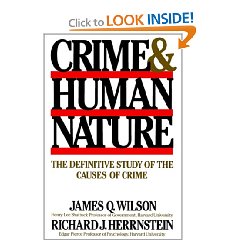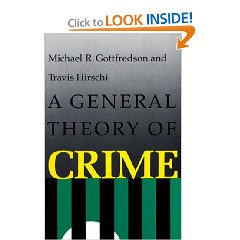Latent Trait Approach
Latent Trait Approach
This is a biological approach assuming that some trait or characteristic, often present at birth, though occasionally acquired early in life, can account for the onset of criminality. Therefore, the propensity for crime remains stable throughout life with only social forces and opportunity influencing the likelihood of criminality. We have talked about a variety of traits in the presence of criminality like ADHD, impulsivity, etc. Suspected latent traits include low IQ, impulsive personality, genetic abnormalities, and even environmental influences. The general idea here is that those who have the trait are at risk of becoming criminals and those who lack the trait have a considerably reduced risk.
Theories:
 Crime and Human Nature (read an in depth review of the book here)
Crime and Human Nature (read an in depth review of the book here)
One of the most widely renowned books in criminality was written by two researchers named Wilson and Hernstein. The book is called Crime and Human Nature. The argument made throughout the book is that personal traits like genetics, IQ, and body build may actually outweigh the importance of social variables as predictors of criminality. Their integrated theory includes elements of biology, sociology, personality, rational choice, structure, and social process theories. According to Wilson and Hernstein, all human behavior is determined by its perceived consequences. The weighing of potential gains and losses are done for certain behaviors to determine which will be acted on. This is a function of rational choice. The larger the perception of rewards, the greater the tendency to commit the crime. The theory is integrative because it assumes that biological and psychological traits influence the choice making process. They find a link between a person's decision to commit crime and such biosocial factors as low IQ, body type, and genetics (parent criminality). Psychological traits including impulsivity or extroversion are also related. These "traits" do not mean a person with them will be a criminal but all things being equal, those who have them are more likely to choose crime over non-crime. Wilson and Hernstein did not ignore the social factors that are known to impact criminality. They feel that biosocial, psychological, and social conditions can all work together to influence behavior patterns. They have assembled a vast amount of support for their notions and theory but critics of their work point out that much of their supporting evidence is plagued by sampling inadequacy, questionable measurement techniques, and observer bias (Meyer and Krienert, 2009, quoted).
 General Theory of Crime
General Theory of Crime
This is possibly the second most important integrated theory of crime. Two criminologists, Gottfredson and Hirschi integrate control theory with biosocial, psychological, routine activities, and rational choice theories. Gottfredson and Hirschi see the criminal offender and the criminal act as two separate concepts. The criminal act, like robberies and burglaries, are negative acts people do when they think it will be advantageous to them. This is like rational choice theory and routine activities in that people weigh rewards and punishments and the accessibility of targets. On the other hand, criminal offenders are individuals who are predisposed to commit crime. This predisposition remains constant over time but the opportunity changes. The key element in Gottfredson and Hirschi's general theory of crime is that individuals vary in their tendency to commit crimes. This is based on an individual's self control. People without good self control tend to be impulsive. Impulsive people are insensitive, physical, risk taking, short sighted, and nonverbal. They have an orientation towards immediate gratification and are less likely to feel share, therefore more likely to engage in criminal acts that they find pleasurable. Similarly, this desire for easy pleasure can be seen in other noncriminal behaviors as well like smoking, drinking, gambling, and illicit sex. Poor self control can be traced to inadequate child-rearing practices. Parents who don't recognize deviant behavior don't punish it and therefore they produce kids who have low self control. The lack of self control is a natural phenomenon that will occur unless steps are taken to avoid it. It occurs early in life and will remain stable into and through adulthood. Unlike most other theories that explain narrow aspects of criminal behavior, Gottfredson and Hirschi argue that their theory of self control applies to all crimes from murder to corporate theft (Meyer and Krienert, 2009, quoted).
Control Balance Theory
This theory proposed by Charles Tittle suggests that control has two main dimensions or components: those amount of control one is subject to by others and the amount of control one can exercise over others. When balance between the two is attained we have rule conformity but when there is an imbalance according to Tittle people choose one of three adaptations to restore or reestablish the balance: 1) predation - involves physical violence against others; 2) defiance - challenges control but does not invoke violence; 3) submission - involves passive obedience to the demands of others.
Most of these theories tend to suggest that people can't or don't really change their lives, for many, once headed down the wrong path the suggestion here is that they continue down the path. Is this true? Think about examples you might be familiar with, people you know, also read a bit about Cody Scott again and look into the background and story of Stanley "Tookie" Williams, also read this - it's an interesting history of The Crips.